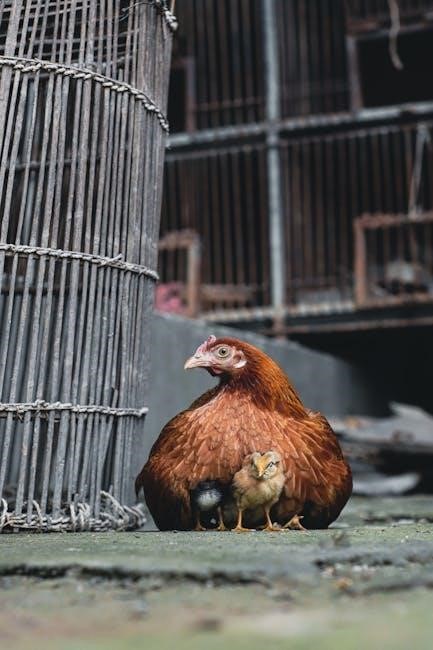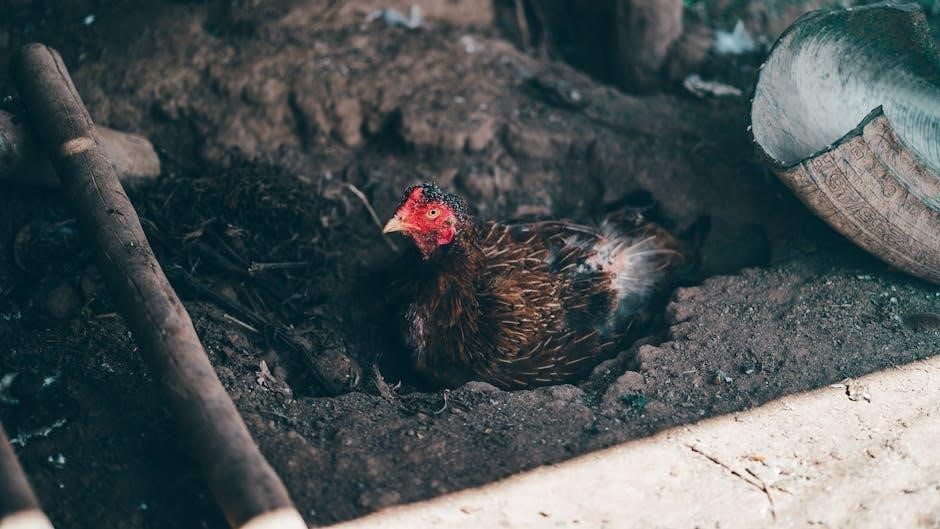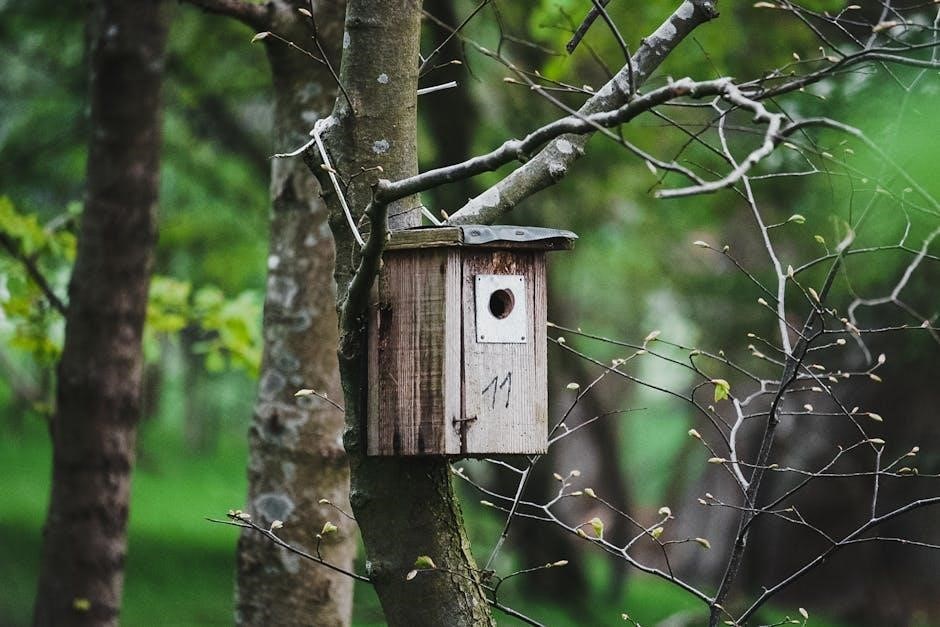chicken nesting box plans pdf
Chicken nesting boxes are essential for providing hens with a safe‚ comfortable space to lay eggs. They come in various designs to suit different breeds and preferences‚ ensuring productivity and reducing stress for your flock. A well-designed nesting box is crucial for promoting egg-laying efficiency and maintaining a clean‚ organized coop environment. Explore the key considerations for selecting or building the perfect nesting boxes for your chickens.
1.1 Importance of Nesting Boxes for Egg Laying
Nesting boxes provide a safe‚ comfortable space for hens to lay eggs‚ reducing stress and encouraging consistent production. They protect eggs from breakage and contamination‚ ensuring cleanliness and quality. Properly designed boxes cater to breed-specific needs‚ promoting efficient egg-laying environments. A dedicated nesting area also helps prevent egg scattering‚ making collection easier and more hygienic for backyard chicken keepers.
1.2 Benefits of Using PDF Plans for Nesting Boxes
PDF plans for nesting boxes offer precise measurements and step-by-step instructions‚ ensuring accurate construction. They provide cost-effective‚ customizable designs to suit various chicken breeds and coop sizes. Detailed diagrams and material lists simplify the building process‚ saving time and effort. These plans also cater to DIY enthusiasts‚ allowing for creative and functional nesting box solutions tailored to specific needs.
Design Considerations for Nesting Boxes
Effective nesting box design focuses on size‚ ventilation‚ and accessibility. Proper dimensions ensure comfort for different breeds‚ while adequate airflow keeps the environment clean and healthy. Easy access features simplify egg collection and maintenance‚ ensuring a seamless experience for both chickens and keepers.
2.1 Size Requirements for Different Chicken Breeds
Nesting box size varies by chicken breed‚ with smaller breeds like bantams requiring boxes around 12×12 inches‚ while larger breeds need more space‚ up to 12x12x12 inches. Ensure boxes are sized appropriately for your flock to promote comfort and egg-laying efficiency. Proper fit prevents stress and ensures hens can move freely while laying eggs.
2.2 Ventilation and Lighting in Nesting Boxes
Proper ventilation is crucial to maintain a healthy environment‚ preventing moisture buildup and ammonia odors. Ensure boxes have small gaps or vents for airflow. Lighting should be soft and indirect to avoid stressing hens‚ while ensuring visibility for egg collection. Natural light is ideal‚ but dim artificial lighting can also work effectively to create a calm laying space.
2.3 Roof and Entrance Design for Easy Access
Proper roof and entrance design ensures easy access for both hens and egg collection. Sloped roofs prevent roosting‚ while secure entrances keep predators out. Durable materials like metal or wood are ideal for longevity. Ensure the design allows for simple cleaning and maintenance‚ enhancing the overall functionality of the nesting boxes for your flock and efficiency.
Materials for Building Nesting Boxes
Wood is the primary material due to its durability and ease of use. Upcycled items like milk crates or plastic containers offer affordable alternatives. Metal and plastic options provide longevity and easy cleaning‚ ensuring a sturdy and hygienic environment for egg laying.
3.1 Wood as the Primary Material
Wood is the most popular choice for nesting boxes due to its durability and ease of use. It provides natural insulation‚ keeping the interior warm in winter and cool in summer. Pine‚ cedar‚ and plywood are common options‚ as they are affordable and easy to work with. Ensure wood is untreated and finished with non-toxic materials to maintain a safe environment for your chickens.
3.2 Upcycled Materials for Affordable Options
Upcycled materials offer an eco-friendly and budget-friendly way to build nesting boxes. Old milk crates‚ wooden crates‚ barrels‚ and even covered litter boxes can be repurposed. These items are often readily available at low costs or for free‚ making them ideal for creative and affordable nesting box solutions. They provide a sustainable way to create functional and cozy spaces for your chickens to lay eggs.
3.3 Metal and Plastic Alternatives
Metal and plastic materials are durable options for nesting boxes‚ offering easy cleaning and long-lasting performance; These materials are ideal for maintaining hygiene and can be found in ready-made designs or built using specific PDF plans. They provide a modern‚ low-maintenance solution for chicken keepers‚ ensuring a clean and efficient egg-laying environment for their flock.

Construction and Assembly
Building nesting boxes requires basic tools and materials. Follow clear PDF plans for a sturdy design‚ ensuring easy assembly and a functional space for egg-laying hens.
4.1 Step-by-Step Guide to Building Nesting Boxes
Start by gathering materials like wood‚ screws‚ and a saw. Follow PDF plans to cut panels to size. Assemble the box frame‚ attach the roof‚ and add bedding. Ensure proper ventilation and easy access for egg collection. Sand edges for safety and paint if desired. Install the box in your coop‚ securing it firmly for stability and durability.
4.2 Tips for Adding External Nesting Boxes
Ensure external nesting boxes are securely attached to the coop to prevent shifting. Choose a location protected from harsh weather and predators. Use durable materials like wood or metal for longevity. Install a ramp for easy access and ensure proper ventilation; Follow PDF plans for precise measurements and installation guidance to guarantee safety and functionality for your flock.
4.3 DIY Projects for Creative Nesting Boxes
Transform everyday items into unique nesting boxes‚ such as old milk crates or wooden barrels‚ to save money and add character. Upcycle materials like covered litter boxes or small enclosures for a rustic look. Add creative features like sloped roofs or curtains for privacy. Ensure functionality by including easy-cleaning designs and proper ventilation. Follow PDF plans for guidance while adding your personal touch for a one-of-a-kind nesting box solution.

Placement and Installation
Ensure nesting boxes are installed at an optimal height for easy access and egg collection. Position them in a quiet‚ clean area to encourage consistent use by your hens.
5.1 Optimal Height and Positioning
Nesting boxes should be placed at a height of 2-4 feet for easy access‚ reducing strain on chickens and simplifying egg collection. Positioning them away from drafts and predator access points ensures safety. Mounting at this height also prevents moisture from reaching the boxes‚ maintaining a clean environment for laying eggs effectively.
5.2 Integrating Nesting Boxes into Chicken Coops
Integrating nesting boxes seamlessly into your coop ensures efficient use of space and easy access for both hens and collectors. Position boxes along the coop’s wall‚ ideally near the entrance‚ to maximize space and reduce stress on the flock. Secure mounting prevents shifting‚ while proper alignment with the coop’s design enhances overall functionality and maintains a tidy interior environment for your chickens.

Maintenance and Cleaning
Regular cleaning of nesting boxes is crucial for maintaining hygiene and encouraging healthy egg production. Remove soiled bedding‚ disinfect surfaces‚ and replace with fresh materials to keep the environment clean and pest-free.
6.1 Best Practices for Keeping Nesting Boxes Clean
Regularly clean nesting boxes to maintain hygiene and prevent pests. Remove soiled bedding‚ disinfect surfaces with a mild detergent‚ and replace with fresh‚ dry materials like straw or wood shavings. Ensure boxes are well-ventilated to reduce moisture and odors. Cleaning frequency depends on usage‚ but aim for at least once a week to keep the environment healthy for your hens.
6.2 Pest Control and Sanitation Tips
Regularly inspect nesting boxes for pests like mites and lice. Use diatomaceous earth or insecticidal powders safely to control infestations. Maintain dry conditions by ensuring proper ventilation and replacing damp bedding. Sanitize surfaces with a pet-safe disinfectant to prevent disease spread. Keeping the area clean and dry deters pests‚ creating a healthier environment for your chickens to lay eggs successfully.

Training Chickens to Use Nesting Boxes
Encourage hens to use nesting boxes by placing them in quiet‚ sheltered areas. Add bedding like straw to make them inviting. Introduce boxes gradually to help chickens adapt and feel secure‚ promoting consistent egg-laying behavior.
7.1 Encouraging Hens to Lay in Designated Areas
To encourage hens to lay in designated nesting boxes‚ ensure the boxes are clean‚ well-bedded‚ and positioned in quiet‚ accessible locations. Place a few artificial eggs in the boxes to attract hens and create a sense of familiarity. Maintain consistent lighting and avoid disturbances near the nesting area to build trust and encourage regular use by your flock.
7.2 Solving Common Issues Like Egg Eating
Egg eating can be addressed by ensuring hens have access to calcium-rich feed and reducing stress in the flock. Placing artificial eggs in nesting boxes discourages hens from eating real ones. Regularly collecting eggs and providing adequate bedding also helps minimize this behavior. Installing a rollout nesting box system can prevent hens from accessing eggs after laying‚ reducing temptation and waste.
Budget-Friendly Nesting Box Plans
Budget-friendly nesting box plans often incorporate recycled materials like old crates or upcycled items. Using affordable materials and simple designs can significantly reduce costs. Free PDF plans online offer creative solutions for building functional nesting boxes without breaking the bank‚ ensuring your flock has a comfortable laying space while staying within your budget.
8.1 Affordable Materials and Designs
Affordable nesting box plans often utilize upcycled materials like old milk crates‚ wooden crates‚ or plastic barrels. These materials are inexpensive and readily available‚ making them ideal for budget-conscious builders. Simple designs with basic dimensions ensure functionality while keeping costs low. Using recycled items not only saves money but also promotes sustainability. These creative solutions provide functional nesting boxes without compromising on quality or comfort for your chickens.
8.2 Free PDF Plans Available Online
Free PDF plans for nesting boxes are widely available online‚ offering step-by-step guides for various designs. These plans cater to different skill levels and budgets‚ making it easy for anyone to build functional nesting boxes. Whether you prefer simple or creative designs‚ downloadable PDFs provide clear instructions to help you get started without additional costs. This resource is perfect for DIY enthusiasts seeking affordable solutions.
Common Mistakes to Avoid
Avoid using incorrect sizing for your chicken breed‚ as it can discourage egg laying. Poor ventilation and lighting are also common errors that negatively impact hen comfort and productivity.
9.1 Incorrect Sizing for Breed-Specific Needs
Using nesting boxes that are too small or large can discourage hens from laying eggs. Bantams require smaller boxes‚ while larger breeds like Brahmas need more space. Standard boxes should be around 12x12x12 inches‚ but sizing must align with your flock’s specific needs to ensure comfort and productivity. Incorrect sizing can lead to stress and reduced egg output.
9.2 Poor Ventilation and Lighting
Poor ventilation and lighting in nesting boxes can lead to unhealthy conditions‚ discouraging hens from laying eggs. Proper airflow prevents ammonia buildup‚ while adequate lighting ensures visibility and safety. Ensure boxes have sufficient windows or ventilation slots for airflow and consider natural light sources to create a welcoming environment for your chickens.
Chicken nesting boxes are vital for egg-laying productivity and flock health. By focusing on design‚ materials‚ and maintenance‚ you can create an ideal environment for your hens to thrive.
10.1 Summary of Key Considerations
When designing chicken nesting boxes‚ prioritize size‚ ventilation‚ and materials. Ensure boxes are breed-appropriate and well-ventilated for hen comfort. Use durable materials like wood or recycled items and maintain cleanliness. Proper placement and training encourage egg-laying efficiency. Avoid common mistakes like poor sizing or ventilation to ensure a productive and healthy flock environment consistently over time.
10.2 Final Tips for Successful Nesting Box Implementation
Ensure boxes are appropriately sized for your chicken breeds and maintain cleanliness to encourage consistent egg-laying. Train hens to use nesting boxes by placing them near feeding areas. Provide adequate ventilation and lighting for comfort. Avoid overcrowding and use durable‚ easy-to-clean materials. Regularly inspect and maintain the boxes to ensure a healthy and productive environment for your flock.
Additional Resources
Explore downloadable PDF plans and guides for building nesting boxes online. Check out DIY communities‚ farming forums‚ and poultry-keeping websites for creative and practical designs.
11.1 Recommended PDF Plans for Download
Downloadable PDF plans offer detailed blueprints for building nesting boxes. Choose from a variety of designs‚ including wooden‚ metal‚ or upcycled materials. Many plans cater to specific breeds‚ ensuring optimal size and comfort. Customize your nesting boxes to fit your coop’s space and your flock’s needs. Explore these resources for practical and creative solutions to enhance your chicken-keeping experience.
11.2 Online Communities for Support and Ideas
Join online forums and communities to connect with fellow chicken keepers. Share experiences‚ ask questions‚ and gather inspiration for nesting box designs. These platforms offer valuable insights‚ tips‚ and creative ideas to help you build or improve your nesting boxes. Engage with experts and enthusiasts to ensure your flock has the best environment for laying eggs effectively and comfortably.
FAQs About Nesting Boxes
Frequently asked questions about nesting boxes address essential topics like necessity‚ number needed per bird‚ and troubleshooting common issues. These answers provide clarity for optimal egg-laying conditions. Discover solutions to ensure a successful and stress-free flock environment with practical advice from experienced chicken keepers and experts in poultry care. This section serves as a quick guide to common inquiries‚ ensuring your nesting boxes meet your flock’s needs effectively and efficiently‚ promoting health and productivity. By understanding these basics‚ you can create a better environment for your chickens to lay eggs comfortably and reduce potential problems. Explore the most frequently asked questions and find reliable solutions to enhance your chicken-keeping experience.
12.1 Do I Need a Nesting Box for My Chickens?
Yes‚ nesting boxes are essential for chickens as they provide a safe‚ secluded space for laying eggs. Chickens instinctively seek privacy and security to lay eggs‚ and without nesting boxes‚ they may lay eggs in unsanitary or hard-to-reach areas. Nesting boxes help keep eggs clean‚ reduce stress‚ and make egg collection easier. They also protect eggs from damage caused by other chickens or predators. Providing nesting boxes ensures a healthier environment and higher egg production. It’s crucial to have enough boxes to accommodate your flock size‚ typically one box for every 3-4 hens‚ depending on breed and coop size. Ensuring each hen has access to a nesting box promotes a well-organized and efficient egg-laying process. This investment supports both chicken health and your egg-gathering efforts‚ making it a necessary component of any chicken coop setup. By prioritizing nesting boxes‚ you create a better living situation for your flock‚ leading to happier‚ healthier chickens and more consistent egg production. Avoid common issues like egg eating or broodiness by ensuring your nesting boxes meet your chickens’ needs. Overall‚ nesting boxes are a vital part of chicken care‚ contributing to both productivity and animal welfare. Regular maintenance and the right design further enhance their effectiveness‚ ensuring your flock remains content and productive. Chickens will naturally seek out nesting boxes‚ so providing them is a key aspect of responsible chicken keeping. By addressing this basic need‚ you support the overall health and productivity of your flock‚ making nesting boxes an indispensable feature of any chicken coop. The benefits of nesting boxes extend beyond egg production‚ contributing to a cleaner‚ more organized living environment for your chickens. Ensuring your flock has access to well-designed nesting boxes is a simple yet effective way to improve their quality of life and the efficiency of your egg collection process. Chickens thrive in environments where their natural behaviors are supported‚ and nesting boxes play a central role in this by providing a dedicated space for laying eggs. By understanding and addressing this need‚ you can create a better environment for your flock‚ leading to happier‚ healthier chickens and more consistent egg production. Nesting boxes are not just a convenience but a necessity for any chicken keeper aiming to maintain a productive and healthy flock. The investment in properly designed nesting boxes pays off in the long run through improved egg quality‚ reduced stress‚ and easier management of your chicken coop. Chickens without access to nesting boxes may become stressed‚ leading to a range of behavioral and health issues. Providing nesting boxes helps prevent these problems‚ ensuring your flock remains happy and productive. In conclusion‚ nesting boxes are a fundamental aspect of chicken care‚ offering numerous benefits that contribute to the overall well-being and productivity of your flock. By incorporating nesting boxes into your chicken coop design‚ you create a supportive environment that meets the natural needs of your chickens‚ leading to better egg production and a healthier flock. The importance of nesting boxes cannot be overstated‚ as they directly impact the comfort‚ health‚ and productivity of your chickens. Ensuring each hen has access to a clean‚ private nesting box is essential for maintaining a thriving flock. Nesting boxes are a simple yet crucial element in chicken care‚ offering a dedicated space for laying eggs and contributing to a well-organized‚ stress-free environment. By providing nesting boxes‚ you support the natural behavior of your chickens‚ leading to a more efficient and enjoyable egg-gathering process. Chickens are creatures of habit‚ and nesting boxes help establish a routine‚ making it easier to care for your flock and collect eggs. The presence of nesting boxes also discourages unwanted behaviors‚ such as egg eating‚ by providing a designated area for laying. This makes nesting boxes a practical and necessary feature for any chicken coop‚ regardless of the flock size or breed. In summary‚ nesting boxes are a vital component of chicken care‚ offering benefits that extend beyond egg production to the overall health and well-being of your flock. By understanding the importance of nesting boxes and ensuring they are well-designed and maintained‚ you can create a better environment for your chickens‚ leading to a more successful and enjoyable chicken-keeping experience. The inclusion of nesting boxes in your chicken coop is not just beneficial but essential for fostering a healthy‚ productive‚ and stress-free flock. Chickens will naturally seek out nesting boxes‚ so providing them is a key aspect of responsible chicken keeping. By addressing this basic need‚ you support the overall health and productivity of your flock‚ making nesting boxes an indispensable feature of any chicken coop. The benefits of nesting boxes extend beyond egg production‚ contributing to a cleaner‚ more organized living environment for your chickens. Ensuring your flock has access to well-designed nesting boxes is a simple yet effective way to improve their quality of life and the efficiency of your egg collection process; Chickens thrive in environments where their natural behaviors are supported‚ and nesting boxes play a central role in this by providing a dedicated space for laying eggs. By understanding and addressing this need‚ you can create a better environment for your flock‚ leading to happier‚ healthier chickens and more consistent egg production. Nesting boxes are not just a convenience but a necessity for any chicken keeper aiming to maintain a productive and healthy flock. The investment in properly designed nesting boxes pays off in the long run through improved egg quality‚ reduced stress‚ and easier management of your chicken coop. Chickens without access to nesting boxes may become stressed‚ leading to a range of behavioral and health issues. Providing nesting boxes helps prevent these problems‚ ensuring your flock remains happy and productive. In conclusion‚ nesting boxes are a fundamental aspect of chicken care‚ offering numerous benefits that contribute to the overall well-being and productivity of your flock. By incorporating nesting boxes into your chicken coop design‚ you create a supportive environment that meets the natural needs of your chickens‚ leading to better egg production and a healthier flock. The importance of nesting boxes cannot be overstated‚ as they directly impact the comfort‚ health‚ and productivity of your chickens. Ensuring each hen has access to a clean‚ private nesting box is essential for maintaining a thriving flock. Nesting boxes are a simple yet crucial element in chicken care‚ offering a dedicated space for laying eggs and contributing to a well-organized‚ stress-free environment. By providing nesting boxes‚ you support the natural behavior of your chickens‚ leading to a more efficient and enjoyable egg-gathering process. Chickens are creatures of habit‚ and nesting boxes help establish a routine‚ making it easier to care for your flock and collect eggs. The presence of nesting boxes also discourages unwanted behaviors‚ such as egg eating‚ by providing a designated area for laying. This makes nesting boxes a practical and necessary feature for any chicken coop‚ regardless of the flock size or breed. In summary‚ nesting boxes are a vital component of chicken care‚ offering benefits that extend beyond egg production to the overall health and well-being of your flock. By understanding the importance of nesting boxes and ensuring they are well-designed and maintained‚ you can create a better environment for your chickens‚ leading to a more successful and enjoyable chicken-keeping experience. The inclusion of nesting boxes in your chicken coop is not just beneficial but essential for fostering a healthy‚ productive‚ and stress-free flock. Chickens will naturally seek out nesting boxes‚ so providing them is a key aspect of responsible chicken keeping. By addressing this basic need‚ you support the overall health and productivity of your flock‚ making nesting boxes an indispensable feature of any chicken coop. The benefits of nesting boxes extend beyond egg production‚ contributing to a cleaner‚ more organized living environment for your chickens. Ensuring your flock has access to well-designed nesting boxes is a simple yet effective way to improve their quality of life and the efficiency of your egg collection process. Chickens thrive in environments where their natural behaviors are supported‚ and nesting boxes play a central role in this by providing a dedicated space for laying eggs. By understanding and addressing this need‚ you can create a better environment for your flock‚ leading to happier‚ healthier chickens and more consistent egg production. Nesting boxes are not just a convenience but a necessity for any chicken keeper aiming to maintain a productive and healthy flock. The investment in properly designed nesting boxes pays off in the long run through improved egg quality‚ reduced stress‚ and easier management of your chicken coop; Chickens without access to nesting boxes may become stressed‚ leading to a range of behavioral and health issues. Providing nesting boxes helps prevent these problems‚ ensuring your flock remains happy and productive. In conclusion‚ nesting boxes are a fundamental aspect of chicken care‚ offering numerous benefits that contribute to the overall well-being and productivity of your flock. By incorporating nesting boxes into your chicken coop design‚ you create a supportive environment that meets the natural needs of your chickens‚ leading to better egg production and a healthier flock. The importance of nesting boxes cannot be overstated‚ as they directly impact the comfort‚ health‚ and productivity of your chickens. Ensuring each hen has access to a clean‚ private nesting box is essential for maintaining a thriving flock. Nesting boxes are a simple yet crucial element in chicken care‚ offering a dedicated space for laying eggs and contributing to a well-organized‚ stress-free environment. By providing nesting boxes‚ you support the natural behavior of your chickens‚ leading to a more efficient and enjoyable egg-gathering process. Chickens are creatures of habit‚ and nesting boxes help establish a routine‚ making it easier to care for your flock and collect eggs. The presence of nesting boxes also discourages unwanted behaviors‚ such as egg eating‚ by providing a designated area for laying. This makes nesting boxes a practical and necessary feature for any chicken coop‚ regardless of the flock size or breed. In summary‚ nesting boxes are a vital component of chicken care‚ offering benefits that extend beyond egg production to the overall health and well-being of your flock. By understanding the importance of nesting boxes and ensuring they are well-designed and maintained‚ you can create a better environment for your chickens‚ leading to a more successful and enjoyable chicken-keeping experience. The inclusion of nesting boxes in your chicken coop is not just beneficial but essential for fostering a healthy‚ productive‚
12.2 How Many Nesting Boxes Do I Need?
A good rule of thumb is to provide one nesting box for every 3-4 hens. Larger breeds may require more space‚ so adjust accordingly. Having one extra box can help prevent overcrowding and stress. Ensure boxes are easily accessible and positioned at a comfortable height to encourage use. This ratio helps maintain a clean and efficient laying environment.
